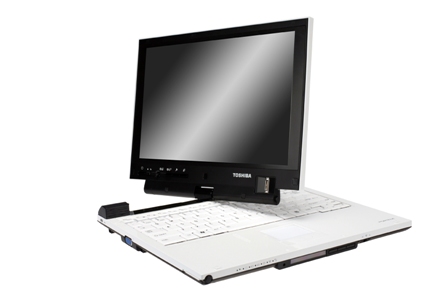The ultimate Windows Vista notebook?

Opening day at CES lasted from sunup to after midnight, but there's no question of the highlight: Toshiba's Portege R400 notebook is the first computer I've seen in a decade that has actually inspired gadget lust in me. In fact, if I had had one of these before I left my hotel room at the start of the day, I would have been able to post this report within an hour.
The R400 was mentioned in Bill Gates' keynote address on Sunday night as the product of two years' of collaborative engineering between Microsoft and Toshiba. The hardware itself is impressive:
- It's small and light. At 3.7 pounds, you don't have to think twice about throwing it in your bag or pulling it out to quickly check some notes.
- The screen is drop-dead gorgeous. The backlit LED uses 42 separate light sources, giving the 1280 x 800 display an unexpected level of clarity.
- An LED-based status display on the front of the machine displays details about appointments and incoming e-mail, pushed down Blackberry-style via Active Notifications. If you hold the closed notebook in your hand, the display is easily visible with a downward glance.
- An integrated EVDO card enables rapid Internet connections even if a wireless access point isn't nearby.
- It's a Tablet PC, which is ideal for taking notes at a tradeshow. (My Tablet PC is in the shop right now, and I miss it. Transferring my chicken scratches from a reporter's notebook to a PC is no fun.) Every premium edition of Windows Vista supports the Tablet features right out of the box.
The R400 looks fabulous, too. It's ultrathin, with a black bezel and scratchproof white case that even a Mac fanatic would love. But the best feature is the $250 wireless docking station, which uses UWB technology to automatically connect the machine when it's within range (three feet or so) of the docking station. The high-bandwidth connection was able to stream video clips to an external monitor with no latency. Surprisingly, the CPU is a Core Duo U2500, not the newer Core 2 Duo - a concession to battery life.

As ZDNet's Dan Ackerman notes in his review, it's frightfully expensive. The price tag for the machine he looked at was around $3500, although entry-level configurations can probably be had for $2500 and change. That means this machine isn't likely to become a best-seller. But for a target market of highly paid mobile professionals who need a small, light, versatile machine, it might be worth the premium. The rest of us will have to wait till the technology trickles down into the next generation of portable PCs.
I'll get the chance to put this machine through its paces in the next few weeks and will have a longer report after I've done so.